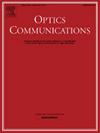Influence of incorporated particles on the optical performance of VO2 nanoparticle-based thermochromic films
IF 2.2
3区 物理与天体物理
Q2 OPTICS
引用次数: 0
Abstract
Vanadium dioxide (VO2) nanoparticle-based thermochromic films are widely used in smart windows because of their favorable thermochromic and optical properties. The introduction of additional particles into VO2 NP-based films enables the integration of their properties with those of the original films. This combination serves to modulate the optical performance of the films further. However, the impact of the incorporated particles on the optical performance of VO2 NP-based thermochromic films has not been elucidated. In this study, the influence of particles with varying refractive indices, volume fractions, and sizes, when incorporated into VO₂ NP-based films, was calculated using the finite-difference time-domain (FDTD) method. The results indicate that an increase in the refractive index or the size of the incorporated particles led to an enhanced solar modulation ability (ΔTsol), albeit at the cost of reducing the luminous transmittance (Tlum). Conversely, increasing the volume fraction of the particles did not significantly enhance the ΔTsol. Additionally, the introduction of additional particles into the film further reduces the total energy consumption by a maximum of 2.6 MJ/m2 compared to VO2 NP-based films, according to EnergyPlus software analysis. Our findings offer new perspectives and recommendations for the development and practical implementation of thermochromic smart windows.
加入的粒子对基于 VO2 纳米粒子的热致变色薄膜光学性能的影响
基于二氧化钒(VO2)纳米粒子的热致变色薄膜具有良好的热致变色和光学特性,因此被广泛应用于智能窗户中。在基于二氧化钒纳米粒子的薄膜中引入额外的粒子,可以将其特性与原始薄膜的特性相结合。这种结合可进一步调节薄膜的光学性能。然而,加入的颗粒对基于 VO2 NP 的热致变色薄膜光学性能的影响尚未阐明。在本研究中,使用有限差分时域(FDTD)方法计算了不同折射率、体积分数和大小的颗粒加入基于 VO₂ NP 的薄膜后的影响。结果表明,增加掺入颗粒的折射率或尺寸可提高太阳调制能力(ΔTsol),但代价是降低透光率(Tlum)。相反,增加颗粒的体积分数并不能显著提高 ΔTsol。此外,根据 EnergyPlus 软件的分析,与基于 VO2 NP 的薄膜相比,在薄膜中引入更多颗粒可进一步降低总能耗,最高可达 2.6 MJ/m2。我们的研究结果为热致变色智能窗的开发和实际应用提供了新的视角和建议。
本文章由计算机程序翻译,如有差异,请以英文原文为准。
求助全文
约1分钟内获得全文
求助全文
来源期刊

Optics Communications
物理-光学
CiteScore
5.10
自引率
8.30%
发文量
681
审稿时长
38 days
期刊介绍:
Optics Communications invites original and timely contributions containing new results in various fields of optics and photonics. The journal considers theoretical and experimental research in areas ranging from the fundamental properties of light to technological applications. Topics covered include classical and quantum optics, optical physics and light-matter interactions, lasers, imaging, guided-wave optics and optical information processing. Manuscripts should offer clear evidence of novelty and significance. Papers concentrating on mathematical and computational issues, with limited connection to optics, are not suitable for publication in the Journal. Similarly, small technical advances, or papers concerned only with engineering applications or issues of materials science fall outside the journal scope.
 求助内容:
求助内容: 应助结果提醒方式:
应助结果提醒方式:


